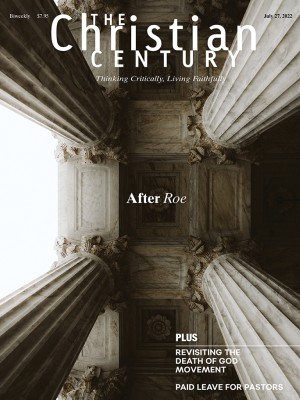My last note from the global church
This specialized column made more sense 14 years ago than it does now.

In 2008, I received a friendly note from David Heim, then the executive editor of the Century, who made an enticing offer that I could scarcely refuse. As he noted, the magazine had long wished to extend its coverage of global affairs and concerns, and he wondered if I might be willing to contemplate a regular column titled Notes from the Global Church. He added that such regular writing could be quite burdensome, but he encouraged me to tackle it for a year, as an experiment. I duly agreed, and my first column appeared that fall.
The experiment has since continued to span 14 years and 183 columns, so I like to think it has been some kind of success. At every stage, I have been exceedingly well treated by the Century and its editors—particularly on the historic day when my column was expanded to cover two pages, with an image to illustrate it!
Read our latest issue or browse back issues.
As a freestanding regular column, Notes from the Global Church will now cease to be published. I will, however, continue to write for the Century under various guises, including that of a regular columnist and a reviewer.
I believe that this move away from a specialized column seeking—overly ambitiously!—to cover the global church is highly appropriate. Indeed, it reflects real progress in the popular awareness of global affairs among Christians. At the turn of the century, it genuinely did come as a shock to many Americans just how large the Christian presence had become in the Global South—and the cultural and moral differences separating older and newer churches. The feuds and schisms in the Anglican Communion made that point tellingly and created a thirst for more information and commentary; hence David’s timely invitation.
In recent years, the situation has changed utterly. Publishers have turned out countless volumes in world or global Christianity, a topic that is now very well covered indeed in seminaries and religion departments. It is also frequently and knowledgeably discussed in the pages of periodicals such as the Century. The day when we might have needed a separate column like this one has passed, and that is wholly a good thing.
Looking back on all those columns, what strikes me most is just how much there was to write about. If pressed, I could probably do 180 or so more, without repeating earlier efforts. In the early years, I concentrated on coverage of the Global South, with a strong emphasis on Africa—reflecting my personal interests and enthusiasms. I was trying to help spread the word about those newer churches, their achievements and struggles. Some countries in particular kept calling me back, the nations that increasingly stand at the forefront of global Christianity, at least in terms of raw numbers. Those landmark nations include Nigeria, Ethiopia, Brazil, and the Philippines.
Over time, I diversified to attempt truly global coverage and devoted a good deal of attention to the older Christian nations of Europe. As I look through those past files, I see some major themes surfacing time and again: secularization and modernization, popular devotion and pilgrimage, the impact of demographic change on faith communities, and the troubled relationship between religious institutions and secular states. I groan to see how much I have written about religious persecution and interfaith wars. Partly to compensate for that, I have repeatedly tried to cover instances where Christians preserved cordial relations with Muslims, Buddhists, and others.
I am pleasantly surprised by just how much I wrote about culture, broadly defined—about films, television, and novels portraying Christian communities in various nations and about how they could provide rich material for teaching about global matters. Music has been a theme when opportunity arose: How do you understand any congregation without its sacred music? Were I to continue, those cultural themes would come ever more strongly to the fore.
As to the many things I have learned through all these columns, the most important, probably, has been what we might call the “end of the Global South” and, consequently, of global/world Christianity. That label once made sense as a convenient overall term, but the more we look at trends in various regions—in Asia as opposed to Africa, say—the more we see the need for new categories, wholly new maps of Christianity worldwide. Christianity in Africa has certain themes in common with Christianity in Asia. But the two continental traditions are so different in so many ways, and those differences are becoming ever more acute. And don’t get me started on Latin America.
Major thanks to everyone who read these columns through the years. Stay global, San Diego.
A version of this article appears in the print edition under the title “After the global church.”






